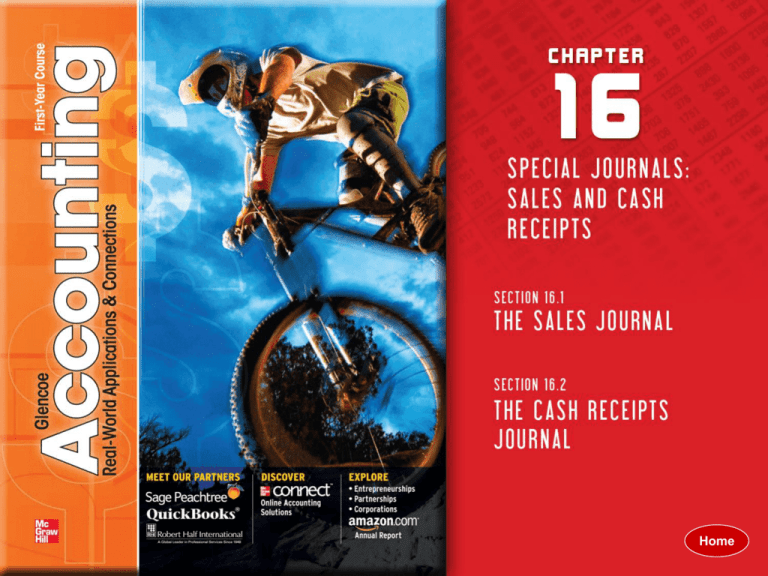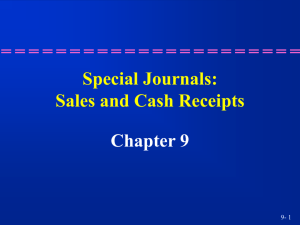
Home
The sales journal is used to record
credit sales of merchandise. The cash
receipts journal is used to record the
cash a business receives.
Home
Glencoe Accounting
Copyright © by The McGraw-Hill Companies, Inc. All rights reserved.
Identify the special journals and explain how they are used in a
merchandising business.
Record transactions in sales and cash receipts journals.
Post from the sales and cash receipts journals to customer accounts
in the accounts receivable subsidiary ledger.
Foot, prove, total, and rule the sales and cash receipts journals.
Post column totals from the sales and cash receipts journals to
general ledger accounts.
Prepare a schedule of accounts receivable.
Home
Glencoe Accounting
Copyright © by The McGraw-Hill Companies, Inc. All rights reserved.
Section 16.1
The Sales Journal
Key Terms
special journals
sales journal
footing
Home
Glencoe Accounting
Copyright © by The McGraw-Hill Companies, Inc. All rights reserved.
Using Special Journals
Section 16.1
The Sales Journal
Sales Journal
Sale of merchandise on account
Most
Commonly
Used Special
Journals
Cash Receipts Journal
Receipt of cash
Purchases Journal
Purchase of any asset on account
Cash Payments Journal
Payment of cash, including payment by check
special journals
Journals that have amount columns for recording debits
and credits to specific general ledger accounts.
Home
Glencoe Accounting
Copyright © by The McGraw-Hill Companies, Inc. All rights reserved.
Journalizing and Posting to
the Sales Journal
Section 16.1
The Sales Journal
Sales Journal
See page 454
sales journal
A special journal used to record only the
sale of merchandise on account.
Home
Glencoe Accounting
Copyright © by The McGraw-Hill Companies, Inc. All rights reserved.
Journalizing and Posting to
the Sales Journal
Section 16.1
The Sales Journal
Recording Sales of Merchandise on Account
Business Transaction
On December 1 The Starting Line sold merchandise on account to
Casey Klein for $200 plus $12 sales tax, Sales Slip 50.
Home
Glencoe Accounting
See page 454
Copyright © by The McGraw-Hill Companies, Inc. All rights reserved.
Journalizing and Posting to
the Sales Journal
Section 16.1
The Sales Journal
Posting a Sale Journal Entry to the
Accounts Receivable Subsidiary Ledger
See page 456
Home
Glencoe Accounting
Copyright © by The McGraw-Hill Companies, Inc. All rights reserved.
Journalizing and Posting to
the Sales Journal
Section 16.1
The Sales Journal
The Sales Credit
Posted
Column
Totals for the
Sales
Journal
The Sales Tax
Payable Credit
The Accounts
Receivable Debit
Home
Glencoe Accounting
Copyright © by The McGraw-Hill Companies, Inc. All rights reserved.
Journalizing and Posting to
the Sales Journal
Section 16.1
The Sales Journal
Footing, Proving, Totaling, and Ruling the Sales Journal
footing
A column total written in small pencil figures.
See page 457
Home
Glencoe Accounting
Copyright © by The McGraw-Hill Companies, Inc. All rights reserved.
Journalizing and Posting to
the Sales Journal
Section 16.1
The Sales Journal
Posting the Total of the Sales Credit Column
Home
Glencoe Accounting
See page 458
Copyright © by The McGraw-Hill Companies, Inc. All rights reserved.
Journalizing and Posting to
the Sales Journal
Section 16.1
The Sales Journal
Posting the Total of the Sales Tax Payable Credit Column
Home
Glencoe Accounting
See page 458
Copyright © by The McGraw-Hill Companies, Inc. All rights reserved.
Journalizing and Posting to
the Sales Journal
Section 16.1
The Sales Journal
Posting the Total of the Accounts Receivable Debit Column
Home
Glencoe Accounting
See page 459
Copyright © by The McGraw-Hill Companies, Inc. All rights reserved.
Journalizing and Posting to
the Sales Journal
Section 16.1
The Sales Journal
Proving the Sales Journal at the End of a Page
Sometimes the transactions will not fit on a single page. When
this occurs, the journal page must be totaled and ruled before a
new page is started.
Home
Glencoe Accounting
See page 460
Copyright © by The McGraw-Hill Companies, Inc. All rights reserved.
Section 16.2
The Cash
Receipts Journal
Key Terms
cash receipts journal
schedule of accounts receivable
Home
Glencoe Accounting
Copyright © by The McGraw-Hill Companies, Inc. All rights reserved.
Journalizing and Posting to
the Cash Receipts Journal
Section 16.2
The Cash
Receipts Journal
The Cash Receipts Journal
Home
Glencoe Accounting
See page 462
cash receipts journal
A special journal used to record all transactions
in which cash is received.
Copyright © by The McGraw-Hill Companies, Inc. All rights reserved.
Journalizing and Posting to
the Cash Receipts Journal
Section 16.2
The Cash
Receipts Journal
Recording Cash from Charge Customers
Business Transaction
On December 5 The Starting Line received $212 from Casey Klein to
apply on account, Receipt 301.
Home
Glencoe Accounting
See page 463
Copyright © by The McGraw-Hill Companies, Inc. All rights reserved.
Journalizing and Posting to
the Cash Receipts Journal
Section 16.2
The Cash
Receipts Journal
Recording Cash Received on Account, Less a Cash Discount
Business Transaction
On December 12 The Starting Line received $1,470 from South Branch
High School Athletics in payment of Sales Slip 51 for $1,500 less the
discount of $30, Receipt 302.
Home
Glencoe Accounting
See page 464
Copyright © by The McGraw-Hill Companies, Inc. All rights reserved.
Journalizing and Posting to
the Cash Receipts Journal
Section 16.2
The Cash
Receipts Journal
Recording Cash Sales
Business Transaction
On December 15 The Starting Line records the cash sales for the first two
weeks of December, $3,000, and $180 in related sales taxes, Tape 55.
Home
Glencoe Accounting
See page 464
Copyright © by The McGraw-Hill Companies, Inc. All rights reserved.
Journalizing and Posting to
the Cash Receipts Journal
Section 16.2
The Cash
Receipts Journal
Recording Bankcard Sales
Business Transaction
On December 15 The Starting Line recorded bankcard sales of $700 for
the first two weeks of December and related sales taxes of $42, Tape 55.
Home
Glencoe Accounting
See page 465
Copyright © by The McGraw-Hill Companies, Inc. All rights reserved.
Journalizing and Posting to
the Cash Receipts Journal
Section 16.2
The Cash
Receipts Journal
Recording Other Cash Receipts
Business Transaction
On December 16 The Starting Line received $30 from Mandy Harris, an
office employee. She purchased a calculator that the business was no
longer using, Receipt 303.
Home
Glencoe Accounting
See page 466
Copyright © by The McGraw-Hill Companies, Inc. All rights reserved.
Journalizing and Posting to
the Cash Receipts Journal
Section 16.2
The Cash
Receipts Journal
Posting to the Accounts Receivable Subsidiary Ledger
Home
Glencoe Accounting
See page 466
Copyright © by The McGraw-Hill Companies, Inc. All rights reserved.
Journalizing and Posting to
the Cash Receipts Journal
Section 16.2
The Cash
Receipts Journal
Posting to the General Credit Column
Home
Glencoe Accounting
See page 467
Copyright © by The McGraw-Hill Companies, Inc. All rights reserved.
Journalizing and Posting to
the Cash Receipts Journal
Section 16.2
The Cash
Receipts Journal
Posting Column Totals
to the General Ledger
See page 469
Home
Glencoe Accounting
Copyright © by The McGraw-Hill Companies, Inc. All rights reserved.
Using the Schedule of
Accounts Receivable
Section 16.2
The Cash
Receipts Journal
To prove the accounts receivable subsidiary ledger,
accountants prepare a schedule of accounts receivable.
schedule of accounts receivable
A list of each charge customer, the balance in the
customer’s account, and the total amount due from
all customers.
Home
Glencoe Accounting
Copyright © by The McGraw-Hill Companies, Inc. All rights reserved.
Using the Schedule of
Accounts Receivable
Section 16.2
The Cash
Receipts Journal
Possible
Errors in the
Subsidiary
Ledger
Failing to Post a
Transaction
Miscalculating an
Account Balance
Proving the accounts receivable subsidiary ledger does not ensure
that transactions were posted to the correct customer account.
Home
Glencoe Accounting
Copyright © by The McGraw-Hill Companies, Inc. All rights reserved.
Internet Sales
Section 16.2
The Cash
Receipts Journal
Use an Internet merchant
account for credit and debit
card payments or an online
payment service.
Internet
Sales
Steps must be taken to make
sure online sales transactions
are secure.
Home
Glencoe Accounting
Copyright © by The McGraw-Hill Companies, Inc. All rights reserved.
Question 1
Use (T) to indicate whether you would post only the column total,
(E) to post each individual transaction, or (B) to post each to the
subsidiary ledger and the column total to the controlling account in
the general ledger.
General Credit
Sales Credit
Sales Tax Payable Credit
Accounts Receivable Credit
Sales Discounts Debit
Cash in Bank Debit
E
__________
T
__________
T
__________
B
__________
T
__________
T
__________
Home
Glencoe Accounting
Copyright © by The McGraw-Hill Companies, Inc. All rights reserved.
Question 2
A company has the following journals and ledgers: sales, cash
receipts, purchases, cash payments, general, and an accounts
receivable subsidiary ledger. For each of the following
transactions, indicate (a) the correct journal and (b) whether the
subsidiary ledger is used.
•
•
•
•
•
•
•
•
sale for cash (a) cash receipts
sale on credit (a) sales (b) A/R subsidiary ledger
payment of accounts payable (a) cash payments
purchase of equipment on credit (a) purchases
cash receipt on account from customer (a) cash receipts (b) A/R subsidiary ledger
sales for customers using bankcards (a) cash receipts
cash received for sale of unneeded equipment (a) cash receipts
cash discount taken on account by customer (a) cash receipts (b) A/R subsidiary ledger
Home
Glencoe Accounting
Copyright © by The McGraw-Hill Companies, Inc. All rights reserved.
Question 3
In the cash receipts journal, why must you post every payment on
account to the customer’s subsidiary account immediately?
Most of the information in the cash receipts journal can be
posted when you total the journal. However, the subsidiary
ledger must be kept current and show the accurate amount
owed by each customer in the event a customer inquires
about his or her account status or that the current total is
needed for some other reason. This also means that until the
column total is posted to the controlling account, the total of
the subsidiary ledger accounts and the controlling account in
the general ledger will not agree.
Home
Glencoe Accounting
Copyright © by The McGraw-Hill Companies, Inc. All rights reserved.
End of
Home



